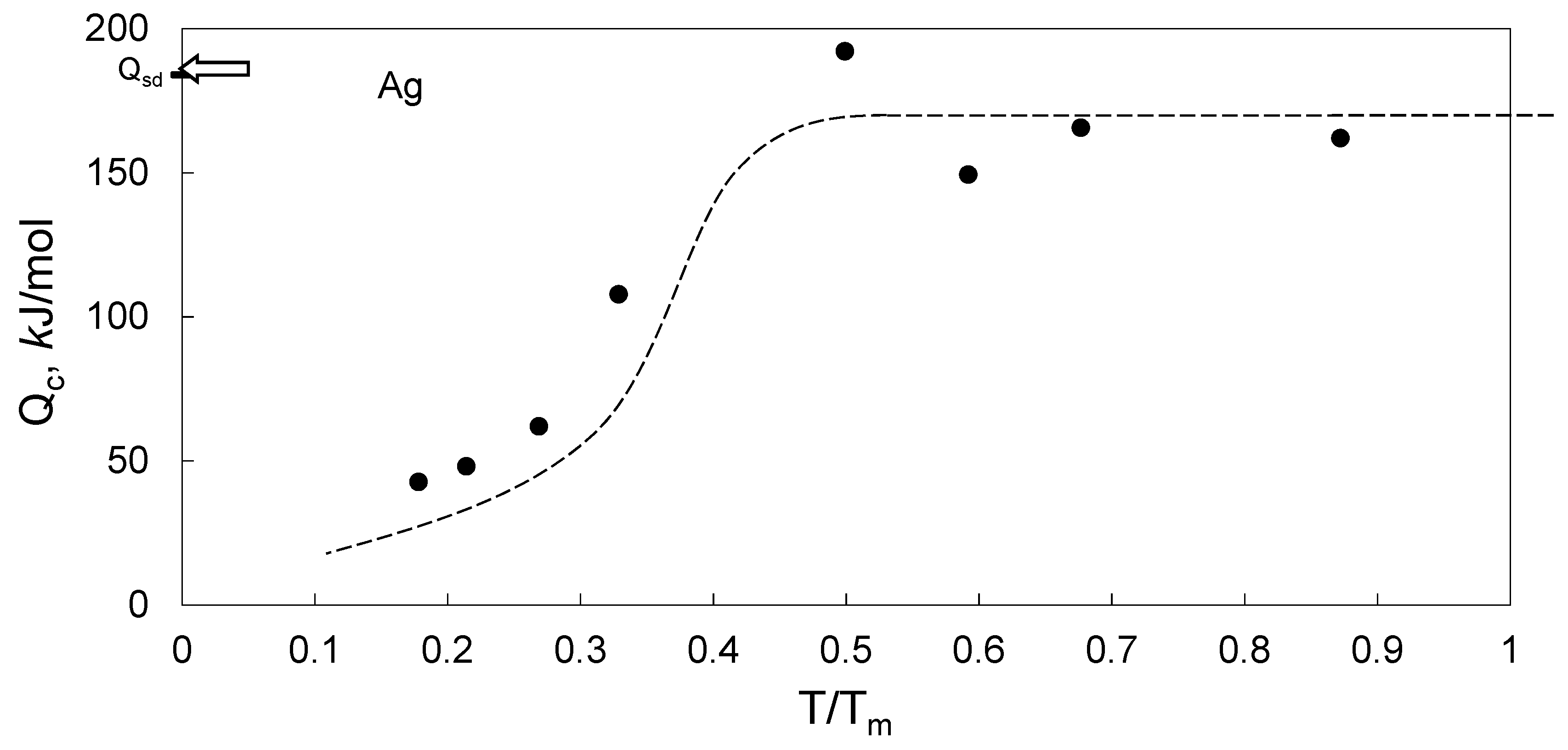Power Law Breakdown in the Creep in Single-Phase Metals
Abstract
1. Introduction
2. Discussion
3. Conclusions
Author Contributions
Funding
Conflicts of Interest
References
- Kassner, M.E. Fundamentals of Creep in Metals and Alloys, 3rd ed.; Elsevier: Amsterdam, The Netherlands, 2015; pp. 1–338. [Google Scholar]
- Kassner, M.E. A case for Taylor hardening during primary and steady-state creep in aluminum and type 304 stainless steel. J. Mater. Sci. 1990, 25, 1997–2003. [Google Scholar] [CrossRef]
- Straub, S.; Blum, W. Does the “Natural” Third Power Law of Steady State Creep Hold for Pure Aluminium. Scr. Metall. Mater. 1990, 24, 1837–1842. [Google Scholar] [CrossRef]
- Blum, W. Hot Deformation of Alloys; Langdon, T.G., Merchant, H.D., Morris, J.G., Zaidi, M.A., Eds.; TMS: Warrendale, PA, USA, 1991; pp. 181–209. [Google Scholar]
- Kassner, M.E. Taylor hardening in five-power-law creep of metals and Class M alloys. Acta Mater. 2004, 52, 1–9. [Google Scholar] [CrossRef]
- Luthy, H.; Miller, A.K.; Sherby, O.D. The stress and temperature dependence of steady-state flow at intermediate temperatures for pure polycrystalline aluminum. Acta Metall. 1980, 28, 169–178. [Google Scholar] [CrossRef]
- Kassner, M.E.; McQueen, H.J.; Pollard, J.; Evangelista, E.; Cerri, E. Restoration mechanisms in large-strain deformation of high purity aluminum at ambient temperature. Scr. Metall. Mater. 1994, 31, 1331–1336. [Google Scholar] [CrossRef]
- Landon, P.R.; Lytton, J.L.; Shepard, L.A.; Dorn, J.E. The Activation Energies for Creep of Polycrystalline Copper and Nickel. Trans. ASM 1959, 51, 900–910. [Google Scholar]
- Kassner, M.E. The rate dependence and microstructure of high-purity silver deformed to large strains between 0.16 and 0.30T m. Metall. Trans. A 1989, 20, 2001–2010. [Google Scholar] [CrossRef]
- Price, C.E. On the creep behavior of silver—I. the oxygen free metal. Acta Metall. 1966, 14, 1781–1786. [Google Scholar] [CrossRef]
- Robinson, S.L.; Sherby, O.D. Mechanical Behavior of Polycrystalline Tungsten at Elevated Temperature. Acta Metall. 1969, 17, 109–125. [Google Scholar] [CrossRef]
- Mecking, H.; Estrin, Y. The effect of vacancy generation on plastic deformation. Scr. Metall. 1980, 14, 15–19. [Google Scholar] [CrossRef]
- Ohashi, T. Generation and accumulation of atomic vacancies due to dislocation movement and pair annihilation. Philos. Mag. 2019, 98, 2275–2295. [Google Scholar] [CrossRef]
- Ungar, T.; Schafler, E.; Hanak, P.; Bernstorff, S.; Zehetbauer, M. Vacancy Production during Plastic Deformation in Copper Determined by in situ X-ray Diffraction. Mater. Sci. Eng. A 2007, 462, 398–401. [Google Scholar] [CrossRef]
- Cizek, M.M.; Janecek, M.; Vlasak, T.; Smola, B.; Melikhova, O.; Islamgaliev, R.K.; Bobatkin, S.V. The Development of Vacancies during Severe Plastic Deformation. Mater. Trans. 2019, 60, 1533–1542. [Google Scholar] [CrossRef]
- Wu, M.Y.; Sherby, O.D. Unification of Harper-Dorn and Power Law Creep through consideration of Internal Stress. Acta Metall. 1984, 32, 1561–1572. [Google Scholar]
- Arieli, A.; Mukherjee, A.K. Creep and Fracture of Engineering Materials and Structures; Wilshire, B., Owen, D.R.J., Eds.; Pineridge Press: Swansea, UK, 1981; pp. 97–111. [Google Scholar]
- Weertman, J.; Weertman, J.R. Physical Metallurgy, 3rd ed.; Cahn, R.W., Haasen, P., Eds.; North Holland: Amsterdam, The Netherlands, 1983; pp. 159–1307. [Google Scholar]
- Nix, W.D.; Ilschner, B. Strength of Metals and Alloys; Haasen, P., Gerold, V., Kostorz, G., Eds.; Pergamon: Aachen, Germany, 1980; pp. 1503–1530. [Google Scholar]
- Kassner, M.E.; Pérez-Prado, M.T.; Long, M.; Vecchio, K.S. Dislocation Microstructures and Internal Stress Measurements by CBED on Creep Deformed Cu and Al. Metall. Mater. Trans. 2002, 33, 311–317. [Google Scholar] [CrossRef]
- Levine, L.E.; Stoudt, M.R.; Creuziger, A.; Phan, T.Q.; Xu, R.; Kassner, M.E. Basis for the Bauschinger Effect in Copper Single Crystals: Changes in the Long-Range Internal Stress with Reverse Deformation. J. Mater. Sci. 2019, 54, 6579–6585. [Google Scholar] [CrossRef]
- Phan, T.Q.; Levine, L.E.; Lee, I.F.; Xu, R.; Tischler, J.Z.; Huang, Y.; Langdon, T.G.; Kassner, M.E. Synchrotron X-Ray Microbeam Diffraction Measurements of Full Elastic Long Range Internal Strain and Stress Tensors in Commercial-Purity Aluminum Processed by Multiple Passes of Equal-Channel Angular Pressing. Acta Mater. 2016, 5, 231–241. [Google Scholar] [CrossRef]
- {alpha}-zirconium at elevated temperatures. Acta Mater. 2004, 53, 581–591.
- Kassner, M.E. Additional Data and Insight bearing on the relation between the dislocation substructure and power law breakdown. Scr. Metall. 1982, 14, 265–266. [Google Scholar] [CrossRef]
- Conway, J.B.; Stentz, R.H.; Berling, J.R. Fatigue, Tensile and Relaxation Behavior of Stainless Steels; Reports TID-26135 United States; Atomic Energy Commission: Washington, DC, USA, 1975; p. 194.
- Trozera, T.A.; Sherby, O.D.; Dorn, J.E. Effect of strain-rate and temperature on the plastic deformation of high purity aluminum. Trans. ASM 1955, 49, 173–185. [Google Scholar]
- Shewmon, P.G. Diffusion in Solids; Bernstorff, S., Zehetbauer, M., Eds.; McGraw-Hill: New York, NY, USA, 1963; p. 66. [Google Scholar]
- Takamura, J.I.; Takahashi, I.; Amano, M. Lattice Defects in Deformed Low-carbon Steels and the Annealing Stage. Trans. Iron Steel Inst. Jpn. 1969, 9, 216–221. [Google Scholar]



© 2019 by the authors. Licensee MDPI, Basel, Switzerland. This article is an open access article distributed under the terms and conditions of the Creative Commons Attribution (CC BY) license (http://creativecommons.org/licenses/by/4.0/).
Share and Cite
Kassner, M.E.; Ermagan, R. Power Law Breakdown in the Creep in Single-Phase Metals. Metals 2019, 9, 1345. https://doi.org/10.3390/met9121345
Kassner ME, Ermagan R. Power Law Breakdown in the Creep in Single-Phase Metals. Metals. 2019; 9(12):1345. https://doi.org/10.3390/met9121345
Chicago/Turabian StyleKassner, M.E., and R. Ermagan. 2019. "Power Law Breakdown in the Creep in Single-Phase Metals" Metals 9, no. 12: 1345. https://doi.org/10.3390/met9121345
APA StyleKassner, M. E., & Ermagan, R. (2019). Power Law Breakdown in the Creep in Single-Phase Metals. Metals, 9(12), 1345. https://doi.org/10.3390/met9121345




